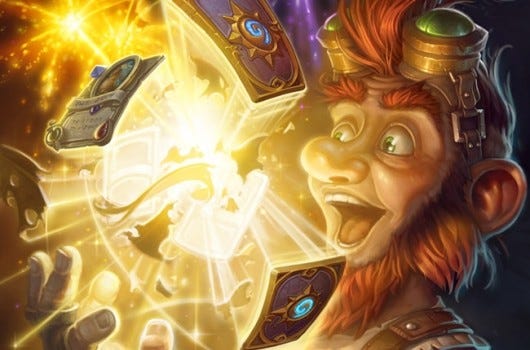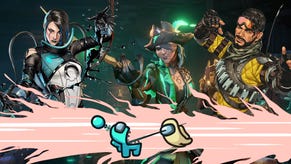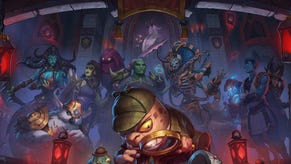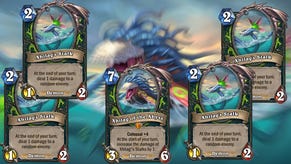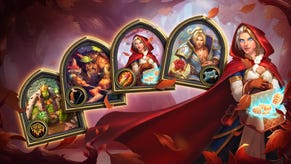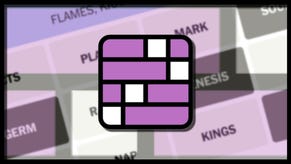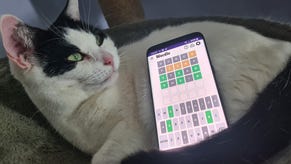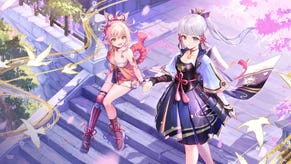Glossary of terms
We've got the lowdown on all of Hearthstone's lingo.
Like most strategy games, Hearthstone has its own dictionary of arcane terminology that can be confusing for newcomers. To help get you up to speed, we've put together a guide to some of the most common terms and acronyms that you might encounter when playing the game, and we recommend that every new player spends a little bit of time familiarising themselves with these concepts.
AOE - Area-of-Effect, a term used for spell damage cards that strike more than one target when played.
Arcane Dust - Hearthstone's crafting currency, created during the act of disenchanting spare or undesired cards from your collection, or through success in the game's Arena mode.
Battlecry - The bonus effect that a minion brings to the table on the same turn that it's played.
Board clear - There are two ways of clearing the board - a massive area-of-effect damage spell that wipes out your opponent's fighting forces, or by using your minions to make favourable trades with their opposite numbers.
Board control - A preferred state of play where you have one or more minions on the board and your opponent has none.
Card Advantage - The advantageous position of having more cards in your hand than your opponent.
Charge - Minions with the Charge ability are capability of taking action the same turn that they're played onto the board.
Coin - The special token awarded to player two, and which provides an additional, single-use extra mana crystal to help eliminate the negative effects of going second in the match.
Combo - Two or more cards which - when played together - either create a new effect, or enhance the primary effect of the other.
Counter - When a card is countered, the effects of the card in question simply do not occur. To date, this special effect can only be caused by the Mage's Counterspell Secret card.
Crafting - Making new cards for your collection through the use of the game's crafting currency, Arcane Dust.
Deathrattle - A minion mechanic that causes it to perform a final action upon death. Note that transformation spells like Hex or Polymorph eliminate Deathrattle effects, as do Silence spells.
Deck - The collection of 30 cards that you assemble in order to participate in a game of Hearthstone.
Discard - Losing cards from your hand, whether through drawing too many (beyond your maximum hand size limit of 10), or through playing minions that cause you to lose cards from your hand.
Disenchanting - The process of destroying a card you no longer wish to keep in your collection, in order to craft new ones from the Arcane Dust that results from disenchanting.
Divine Shield - A protective bubble that surrounds certain minions. The minion's health pool cannot be damaged while the shield is active.
Draft - In Arena, you are presented with 30 collections of three cards, from which you must choose a single card each turn. The end result is known as your draft.
Drawing Power - The ability to draw additional cards beyond the single card awarded to each player at the start of a new turn.
Durability - Weapons have an Attack value and a Durability value. Each time the weapon is used it will lose a point of Durability. When this value reaches zero, the weapon is destroyed.
Early Game - Somewhere around the first three or four turns of a game of Hearthstone.
Enemy - The Hero and minions on the opposite side of the board from you!
Enrage - A mechanic which forces a change in a minion's behaviour when it is damaged. Note that an Enraged minion that is healed back to full health will lose the Enrage effect.
Exhaustion - The condition of a summoned minion which prevents it from being played on the turn it appears. Certain minions possess the Charge ability which negates this effect.
Fatigue - A system which begins when a player runs out of cards. Each attempt to draw a card from the empty pool inflicts a steadily increasing penalty against your Hero's health.
Favourable trading - The process of using weaker minions or spells to take out more valuable threats.
Freeze - A mechanic which doesn't damage a minion - or minions - by itself, but will prevent them from being utilised for a single turn.
Gold - Hearthstone's currency. Used to participate in Arena runs and purchase new card packs.
Gold cards - Gold-plated, animated versions of regular cards. These cost considerably more Arcande Dust to craft, but confer no non-cosmetic advantages.
Going first / second - The player going second receives an extra card and The Coin, which can be used to grant the one-time use of a single extra mana. This is intended to counter the tempo advantage gained by the player going first.
Hand - Your hand is comprised of the cards available to you on your current turn (Mana cost notwithstanding).
Heal - The process of restoring a minion or Hero's health after they've taken damage.
Health - The amount of damage a minion or Hero can sustain before expiring. There is no theoretical limit to the amount of health a minion can be granted through enhancements.
Hero - The character associated with each of Hearthstone's nine classes.
Hero Power - Each Hero possesses a unique ability that costs two mana.
Immune - Minions temporarily granted Immune status cannot be damaged while the effect is active, although they can still be removed by cards like Polymorph.
Late-game - A period of the game that's generally considered to commence at turn nine.
Mana - Hearthstone's resource that determines the number and type of cards you can play each turn. Each player is automatically given one extra Mana to utilise with each successive turn.
Mana curve - Take the number of cards you are able to play on any given turn, and visualise them as a bar chart from turns one to 10. This is your Mana curve.
Meta-game - The shift in deck popularity that occurs over time as new strategies are first discovered and then countered.
Mid-game - The turns that take place when both players have approximately four to eight mana.
Mill - Forcing your opponent to draw cards until their hand is overwhelmed and they are forced to throw away the new cards they draw. The process of milling ultimately causes players to enter the Fatigue system.
Minion - The creatures you play onto the board. These creatures remain in play until their health is reduced to zero, or the opponent removes them with a spell.
MMR - Matchmaking Rating. Each mode of the game - Arena, Ranked, Casual - has its own separate rating system which attempts to match you up against players with a similar win/loss ratio.
Mulligan - The cards you choose to keep at the start of the game, rather than returning to the pile for a re-draw.
Overload - A mechanic unique to Shamans that allows them to borrow Mana from the next turn in order to spend it on the current turn.
Over-extend - The process of placing too many minions on the board, and risking significant loss of tempo should the opponent wipe the board with an area-of-effect ability.
Quest - An objective with a reward, such as a Daily Quest, or a one-time achievement.
Rarity - Hearthstone cards are separated into five ranks of rarity: Basic, Common, Rare, Epic and Legendary. Basic cards are unlocked by levelling each Hero to 10. The others are crafted or found in packs.
Removal - The process of eliminating an enemy minion from the board, whether though weapon use, spell damage, Hero Powers or minion trading.
RNG - Random Number Generation. Many Hearthstone cards have a random effect when played. For example, Ragnaros delivers 8 points of damage to a random enemy target at the end of each turn.
Rush - A style of play that focuses on reducing the opposing Hero's health pool to zero as quickly as possible.
Secret - Cards available to Hunters, Paladins and Mages. The particular Secret in play is only visible to its owner, and can only be triggered on the opponent's turn.
Silence - Negates any special enhancements on a minion, but does not reverse the effects of cards like Polymorph or Hex.
Spell - A card that neither summons a minion or equips a weapon, but nevertheless has some kind of effect on the battlefield.
Spell Damage + - Increases the numerical power of your spell damage cards.
Stealth - Puts a minion in a state where it cannot be targeted by spells or minions. Note that area-of-effect damage that does not require targeting can still affect the stealthed minion.
Summon - The process of putting a minion into play on the board, either by the player or by another minion.
Synergy - Cards that became exponentially more powerful or useful when played together in the same deck.
Targeting - The process by which you specifically aim a minion, weapon, spell or Hero Power against the other player's Hero or minions.
Taunt - Minions with Taunt must be dealt with before you can damage the opposing Hero or their minions. Does not apply to spells or non-melee Hero Powers.
Topdeck - The next card you pull from your deck. A term often used in the late stages of a long game, where both players have empty hands and depend on the next card they draw to remain competitive.
Trading - The process of using your minions to remove an opponent's threats.
Turn - You and your opponent's opportunities to play cards up the Mana value of the current round.
Vanilla - Cards which have no special enhancements beyond their health and attacking values.
Weapon - Warriors, Shamans, Rogues and Paladins can wield weapons with a specific attack value, as well as a durability value. When the weapon loses all of its durability, it's destroyed.
Windfury - Allows a minion to attack twice in a single turn, but only if it survives the first attack.
Zerg - see Rush.
